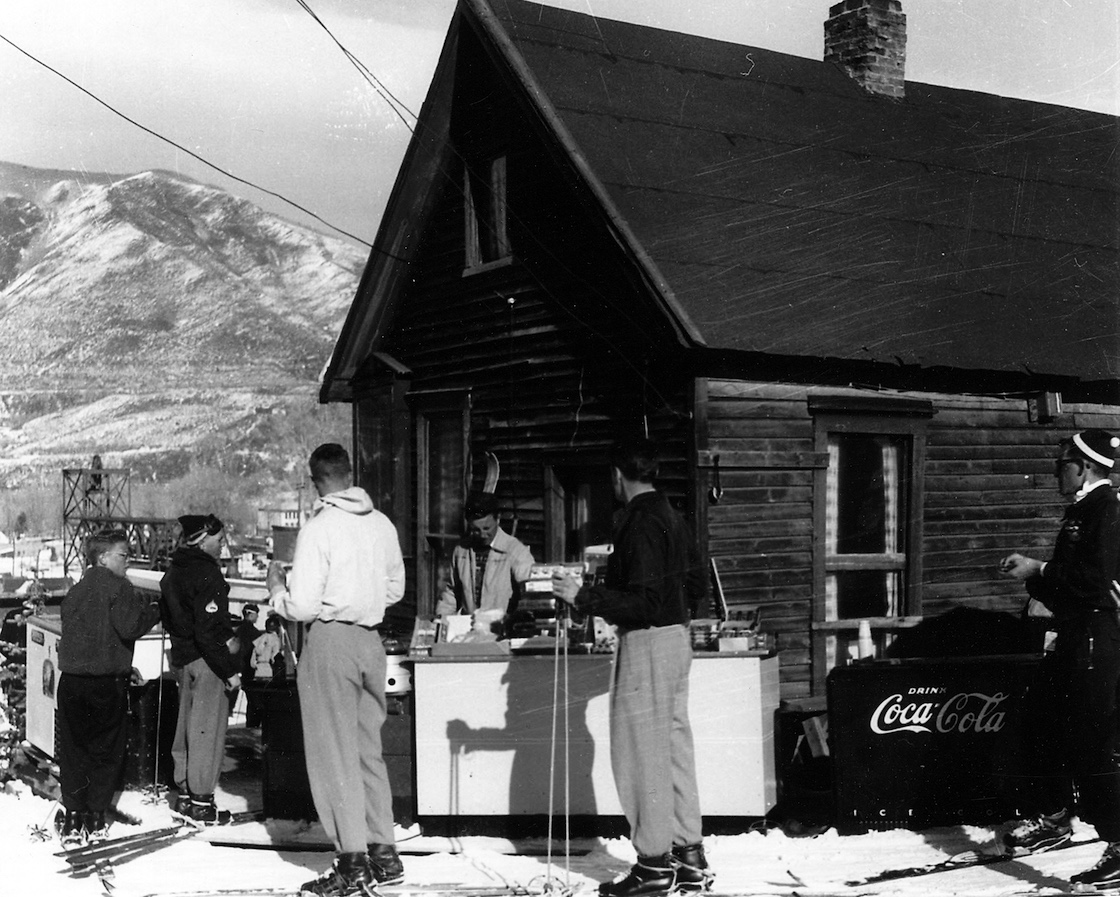Lunch Lines
Besides your choice line down a powder-filled run, lines are rarely a welcome sight on a ski hill. Add a made-to-order burger into the equation, however, and waiting in a lift line doesn’t seem so bad.
The Ski Inn Restaurant, one of Aspen Mountain’s original eateries, revolutionized lunch on the go with lift-line delivery. Housed in a wooden cabin at the base of Lift One (on the west side of the mountain near where Lift 1A, the Shadow Mountain chair, is today), the “refreshment hut” took orders from skiers as they approached the lift and delivered their lunch in line to be enjoyed on the long singlechair ride to the top.
Entrepreneurial part-time Aspenites Chuck Worth and Jerry Kochka had renovated an old house into this short-order restaurant. In The Aspen Times on March 23, 1950, the duo announced the opening of “the world’s first Ski Inn, Aspen’s version of a drive-inn [sic], directly under the world’s longest chair lift.” The menu featured typical lunch fare: “a large table spread with sandwiches,” coffee, and Coca-Cola. Hot tea, chocolate milk, and apples were 10 cents, “hamburgs” were offered at 25 cents, and hot dogs and candy bars cost skiers 5 cents.
Unfortunately for early riders of Lift One, the hut burned down in 1953 in a blaze that likely started from grease on an overheated grill. Though no other on-mountain establishment has offered such expeditious delivery service since, dining on the hill has perhaps become as popular a ritual as skiing itself.
Following the fire, the Ski Inn’s second owners, Howard and Jean Awrey (who also operated the Sundeck at the time), filled the gap in base-area eats with the Skier’s Caf . Built slightly uphill from the Ski Inn the following year, the still-standing, chalet-style building would eventually become the Skier’s Chalet Steakhouse, which lasted until 2005. (The historic building is slated to once again serve food and drinks under a redevelopment plan for the neighborhood.)
Another innovative establishment called the Wayward Bus (think Aspen’s first food truck) also offered on-the-go fare for skiers in the first few decades of Lift One. Likely named by a Steinbeck fan, the lunch counter advertised “curb service” and was run by Stan Johnson, Dean Billings, and Ralph Jackson. As skiing on Aspen Mountain boomed in the years that followed, Ruthie’s Restaurant, further upslope at the top of Lift 1A, opened in the early 1980s and served skiers until it closed 2006.
Though the challenges of operating full-service restaurants as high as 11,212 feet are great, the mountain’s culinary mainstays have become Aspen bucket-list destinations. The Sundeck, originally designed by Herbert Bayer, was a hard sell for Aspen Mountain visionary Friedl Pfeifer, who had to persuade investors of the need for a warming hut at the top of the lifts, complete with a restaurant and bathrooms, “especially for our lady skiers,” Pfeifer wrote in his biography, Nice Goin’: My Life on Skis. However, since opening in 1946 in conjunction with the first Lift One, it has become internationally renowned for its high-altitude views and high-end fare. Now in its 75th anniversary season, following several renovations and boasting a LEED-certified, environmentally friendly design, it is not uncommon for guests to ride the gondola sans skis to enjoy lunch on the deck.
Perhaps even more popular among some skiers and riders (despite lacking direct lift access), Bonnie’s, previously Gretl’s, originally opened in 1966 as Tourtelotte Restaurant. A pit-stop panacea, its legendary apple strudel, pancakes, soups, and sandwiches draw fans of all ages. These days, the scene at Bonnie’s is often the only line you’ll see on Aspen Mountain.
Edible Traditions is produced by the Aspen Historical Society. For access to the full online archives, including more than 10,000 historic images, visit AspenHistory.org or call (970) 925-3721.





